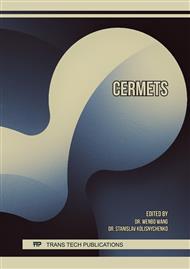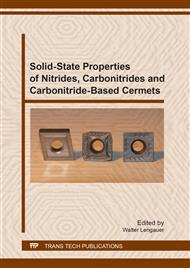[1]
P. Ettmayer, H. Kolaska, W. Lengauer, K. Dreyer, Ti(C, N) cermets-metallurgy and properties, Int. J. Refract. Met. Hard Mater. 13 (1995) 343-351.
DOI: 10.1016/0263-4368(95)00027-g
Google Scholar
[2]
Y. Zheng, W.J. Liu, S.X. Wang, W.H. Xiong, Effect of carbon content on the microstructure and mechanical properties of Ti(C, N)-based cermets, Ceram. Int. 30 (2004) 2111-2115.
DOI: 10.1016/j.ceramint.2003.11.016
Google Scholar
[3]
D. Moskowitz, L.L. Terner, TiN improves properties of titanium carbonitride based materials. Int. J. Refract. Met. Hard. Mater. 5 (1986) 131-139.
Google Scholar
[4]
Y. Zheng, W.H. Xiong, W.J. Liu, W. Lei, Q. Yuan, Effect of nano addition on the microstructures and mechanical properties of Ti(C, N)-based cermets, Ceram. Int. 31 (2005) 165-170.
DOI: 10.1016/j.ceramint.2004.04.005
Google Scholar
[5]
Y.J. Zhao, Y. Zheng, W. Zhou, J.J. Zhang, G.T. Zhang, W.H. Xiong, Microstructure and performance of functionally gradient Ti(C, N)-based cermets fabricated by low-pressure carburizing treatment during liquid phase sintering, Ceram. Int. 43 (2017).
DOI: 10.1016/j.ceramint.2016.10.159
Google Scholar
[6]
W. Zhou, Y. Zheng, Y.J. Zhao, Y.P. Ma, W.H. Xiong, Microstructure characterization and mechanical properties of Ti(C, N)-based cermets with AlN addition, Ceram. Int. 41 (2015) 5010-5016.
DOI: 10.1016/j.ceramint.2014.12.068
Google Scholar
[7]
S. Bolognini, G. Feusier, D. Mari, T. Viatte, W. Benoit, TiMoCN-based cermets: high temperature deformation, Int. J. Refract. Met. Hard Mater. 21 (2003) 19-29.
DOI: 10.1016/s0263-4368(02)00091-4
Google Scholar
[8]
E.B. Clark, B. Roebuck, Extending the application areas for titanium carbonitride cermets, Int. J. Refract. Met. Hard Mater. 11 (1992) 23-33.
DOI: 10.1016/0263-4368(92)90081-c
Google Scholar
[9]
Y.J. Zhao, Y. Zheng, W. Zhou, J.J. Zhang, G.T. Zhang, W.H. Xiong, Microstructure and performance of functionally gradient Ti(C, N)-based cermets fabricated by low-pressure carburizing treatment during liquid phase sintering, Ceram. Int. 43 (2017).
DOI: 10.1016/j.ceramint.2016.10.159
Google Scholar
[10]
H. Yu, Y. Liu, Y. Jin, J. Ye, Effect of secondary carbides addition on the microstructure and mechanical properties of (Ti,W,Mo,V)(C,N)-based cermets, Int. J. Refract. Met. Hard. Mater. 29 (5) (2011) 586-590.
DOI: 10.1016/j.ijrmhm.2011.03.013
Google Scholar
[11]
X.B. Zhang, N. Liu, C.L. Rong, Effect of molybdenum content on the microstructure and mechanical properties of ultra-fine Ti(C,N) based cermets, Mater. Charact. 59 (2008) 1690-1696.
DOI: 10.1016/j.matchar.2008.03.008
Google Scholar
[12]
T. Cutard, T. Viatte, G. Feusier, W. Benoit, Microstructure and high temperature mechanical properties of TiC0.7N0.3-Mo2C-Ni cermets, Mater. Sci. Eng. A. 209 (1996) 218-227.
DOI: 10.1016/0921-5093(95)10100-4
Google Scholar
[13]
S.Y. Ahn, S. Kang, Effect of WC particle size on microstructure and rim composition in the Ti(C0.7N0.3)-WC-Ni system, Scripta Mater. 55 (11) (2006) 1015-1018.
DOI: 10.1016/j.scriptamat.2006.08.008
Google Scholar
[14]
J. Wang, Y. Liu, P. Zhang, J.C. Peng, J.W. Ye, M.J. Tu, Effect of WC on the microstructure and mechanical properties in the Ti(C0.7N0.3)-xWC-Mo2C-(Co,Ni) system, Int. J. Refract. Met. Hard. Mater. 27 (2009) 9-13.
DOI: 10.1016/j.ijrmhm.2008.01.010
Google Scholar
[15]
Q.Q. Yang, W.H. Xiong, S.Q. Li, H.X. Dai, J. Li, Characterization of oxide scales to evaluate high temperature oxidation of Ti(C, N)-based cermets in static air, J. Alloys Compd. 506 (2010) 461-467.
DOI: 10.1016/j.jallcom.2010.07.031
Google Scholar
[16]
D.S. Park, P. Chan, Y.D. Lee, Oxidation of Ti(C,N)-based ceramics exposed at 1373 K in air, J. Am. Ceram. Soc. 83 (3) (2010) 672-674.
Google Scholar
[17]
D.K. Shetty, I.G. Wright, P.N. Mincer, A.H. Clauer, Indentation fracture of WC-Co cermets, J. Mater. Sci. 20 (1985) 1873-1882.
DOI: 10.1007/bf00555296
Google Scholar
[18]
S.Y. Ahn, S. Kang, Formation of core/rim structures in Ti(C,N)-WC-Ni cermets via a dissolution and precipitation process, J. Am. Ceram. Soc. 83 (2000) 1489-1494.
DOI: 10.1111/j.1151-2916.2000.tb01415.x
Google Scholar
[19]
S. Kim, K.H. Min, S. Kang, Rim structure in Ti(C0.7N0.3)-WC-Ni cermets, J. Am. Ceram. Soc. 86 (2003) 1761-1766.
DOI: 10.1111/j.1151-2916.2003.tb03551.x
Google Scholar
[20]
J. Qu, W.H. Xiong, D.M. Ye, Z.H. Yao, W.J. Liu, S.J. Lin, Effect of WC content on the microstructure and mechanical properties of Ti(C0.5N0.5)-WC-Mo-Ni cermets, Int. J. Refract. Met. Hard. Mater. 28 (2) (2010) 243-249.
DOI: 10.1016/j.ijrmhm.2009.10.005
Google Scholar
[21]
X.B. Zhang, N. Liu, Microstructure, mechanical properties and thermal shock resistance of nano-TiN modified TiC-based cermets with different binders, Int. J. Refract. Met. Hard. Mater. 26 (6) (2008) 575-582.
DOI: 10.1016/j.ijrmhm.2008.01.008
Google Scholar
[22]
E. Chicardi, F.J. Gotor, J.M. Córdoba, Enhanced oxidation resistance of Ti(C,N)-based cermets containing Ta, Corros. Sci. 84 (8) (2014) 11-20.
DOI: 10.1016/j.corsci.2014.03.007
Google Scholar
[23]
E. Butchereit, K.G. Nickel, A. Muller, Precursor-derived Si-B-C-N ceramics:oxidation kinetics, J. Am. Ceram Soc. 84 (10) (2001) 2184-2188.
DOI: 10.1111/j.1151-2916.2001.tb00985.x
Google Scholar
[24]
C.L. Zeng, G.Q. Liu, W.T. Wu, Oxidation behavior of Ni-Ti alloys at 650-850℃ in air, Acta Metall. Sin. 37 (8) (2001) 861-864.
Google Scholar
[25]
K. Bhuntumkomol, K.N. Han, F. Lawson, The leaching behaviour of nickel oxides in acid and in ammoniacal solutions, Hydrometallurgy. 8 (2) (1982) 147-160.
DOI: 10.1016/0304-386x(82)90041-x
Google Scholar
[26]
P. Kofstad, High-temperature oxidation of titanium, J. Less-Common Met. 12 (6) (1967) 449-464.
DOI: 10.1016/0022-5088(67)90017-3
Google Scholar
[27]
F. Cai, C.W. Nan, R.Z. Yuan, The oxidation behavior of (Nb, Ti)C-Ni cermet, J. Chin. Ceram. Soc. 23 (2) (1995) 224-228.
Google Scholar
[28]
F. Monteverde, A. Bellosi, Oxidation behaviour of titanium carbonitride based materials, Corros. Sci. 44 (2002) 1967-(1982).
DOI: 10.1016/s0010-938x(01)00142-1
Google Scholar
[29]
Q.Q. Yang, W.H. Xiong, S.Q. Li, Z.H. Yao, X. Chen, Early high temperature oxidation behaviour of Ti(C,N)-based cermets in air, Corros. Sci. 52 (10) (2010) 3205-3211.
DOI: 10.1016/j.corsci.2010.05.028
Google Scholar



